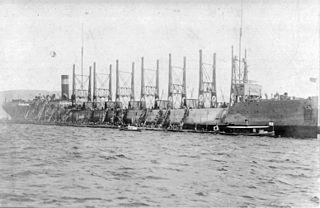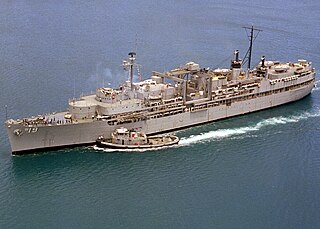 United States Naval Academy Midshipmen furl sails aboard the ship in her period as Naval Academy training ship 1900–10 | |
| History | |
|---|---|
| Name: | USS Chesapeake and USS Severn |
| Namesake: |
|
| Builder: | Bath Iron Works, Bath, Maine |
| Laid down: | 2 August 1898 |
| Launched: | 30 June 1899 |
| Sponsored by: | Miss Elise Bradford |
| Commissioned: | 12 April 1900 |
| Decommissioned: | 3 October 1916 (final time) |
| Renamed: | USS Severn, 15 June 1905 |
| Reclassified: | submarine tender 1910 |
| Fate: | Sold 7 December 1916 |
| General characteristics | |
| Type: |
|
| Displacement: | 1,175 long tons (1,194 t) |
| Length: | 224 ft 3 in (68.35 m) |
| Beam: | 37 ft (11 m) |
| Draft: | 16 ft (4.9 m) |
| Propulsion: | Sails plus auxiliary steam power |
| Sail plan: | Three-masted full-rigged ship |
| Complement: |
|
| Armament: |
|
The third USS Chesapeake and second USS Severn was a three-masted, sheathed, wooden-hulled full-rigged ship with auxiliary steam power in commission in the United States Navy during most of the period between 1900 and 1916.

The mast of a sailing vessel is a tall spar, or arrangement of spars, erected more or less vertically on the centre-line of a ship or boat. Its purposes include carrying sail, spars, and derricks, and giving necessary height to a navigation light, look-out position, signal yard, control position, radio aerial or signal lamp. Large ships have several masts, with the size and configuration depending on the style of ship. Nearly all sailing masts are guyed.

Wood is a porous and fibrous structural tissue found in the stems and roots of trees and other woody plants. It is an organic material, a natural composite of cellulose fibers that are strong in tension and embedded in a matrix of lignin that resists compression. Wood is sometimes defined as only the secondary xylem in the stems of trees, or it is defined more broadly to include the same type of tissue elsewhere such as in the roots of trees or shrubs. In a living tree it performs a support function, enabling woody plants to grow large or to stand up by themselves. It also conveys water and nutrients between the leaves, other growing tissues, and the roots. Wood may also refer to other plant materials with comparable properties, and to material engineered from wood, or wood chips or fiber.

A hull is the watertight body of a ship or boat. The hull may open at the top, or it may be fully or partially covered with a deck. Atop the deck may be a deckhouse and other superstructures, such as a funnel, derrick, or mast. The line where the hull meets the water surface is called the waterline.
























